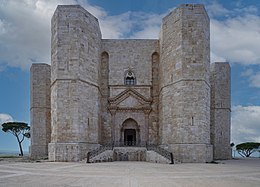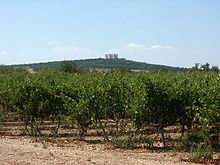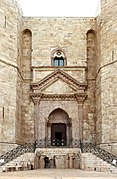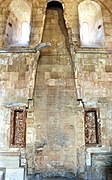Castel del Monte, Apulia
| Castel del Monte | |
|---|---|
| Andria | |
 Castel del Monte | |
 | |
| Coordinates | 41°05′05″N 16°16′15″E / 41.0847535°N 16.2709346°E |
| Site history | |
| Built | 1240–1250 |
Castel del Monte (
The castle is famous for its bold octagonal plan, and classicizing details of the architecture. In 1996, Castel del Monte was named a
Location

Castel del Monte is situated on a small hill close to the
, occupying the site of an earlier fortress of which no structural remains exist.A document dating to 1240, in which
Description

Because of its relatively small size, it was once considered to be no more than a "
Both floors have eight rooms, and an eight-sided courtyard occupies the castle's centre.

The octagonal plan is unusual in castle design. Historians have debated the purpose of the building and it has been suggested that it was intended as a hunting lodge.[8] Another theory is that the octagon is an intermediate symbol between a square (representing the earth) and a circle (representing the sky). Frederick II may have been inspired to build to this shape by either the Dome of the Rock in Jerusalem, which he had seen during the Sixth Crusade, or by the Palatine Chapel of Aachen Cathedral.
Occasionally used as a hunting lodge under
The main wall is 25 m (82 ft) high and the eight bastions each 26 m (85 ft). The sides of the main octagon are 16.5 m (54 ft) long and those of the octagonal towers each 3.1 m (10 ft). The castle has a diameter of 56 m (184 ft). Its main entrance faces east.
Modern era

In the 18th century, the castle's marbles and other ornamentation were looted. Members of the
During the
In the 1950s, soil around the castle was discovered to contain a bright red compound produced by a strain of the bacterium Streptomyces peucetius. Scientists named the drug daunorubicin and further development identified a related compound doxorubicin that finds use as a chemotherapeutic agent used to treat cancer.[10]
Central to the plot of Umberto Eco's novel The Name of the Rose is an old fortress known as the 'Aedificium'. This was almost certainly inspired by Castel del Monte.[11][12] It was also the set for the film Tale of Tales.
Castel del Monte is depicted on the reverse of the Italian version of the one cent Euro coin.
The castle has been often mistakenly linked to the
Castel del Monte DOC wine

Around the castle is the
Red and rose grapes are limited to a
Gallery
-
Entrance
-
Stairs inside the castle
-
Courtyard
-
View from the courtyard
-
Throne room
-
Fireplace remains
-
Tower ceiling
See also
- Cultural depictions of Frederick II, Holy Roman Emperor
- Arch of Augustus (Rimini) – an ancient Roman city gate said to share architectural references with the Castel del Monte[17]
References
- ^ a b c d e Castex 2008, p. 21
- ^ ISBN 978-0-600-01635-9
- ^ 398rev list entry; World Heritage Committee, Report of the 20th Session, Merida 1996
- ^ Enciclopedia Italiana. Retrieved 19 July 2011.
- ^ "Images of Euro Coins - 1 cent". Retrieved 20 November 2022.
- ^ Castex 2008, p. 20
- ^ Tuulse 2002, pp. 60–61
- ^ Castex 2008, p. 22
- ^ "Castel del Monte, Castelli della Puglia, provincia di Barletta Andria Trani, pag. 1".
- ^ Haft & White 1999, p. 154
- ^ Castel del Monte, in-italia.com, archived from the original on 12 June 2009, retrieved 29 September 2008
- ^ "Morto il medioevalista Raffaele Licinio".
- ^ "Prontuario contro gli stereotipi e le interpretazioni fanta-esoteriche su Castello del Monte (article published on stupormundi.it)".
- ^ "Morto il prof. Raffaele Licinio, esperto di Castel del Monte e del medioevo". 4 February 2018.
- ISBN 1-55297-720-X
- ^ Valdameri, Carlo (2015). "Le torri poligonali" [The polygonal towers] (PDF). Ariminum. November–December 2015 (in Italian). Rimini Rotary Club: 16–17. Retrieved 16 February 2024.
Sources
- Castex, Jean (2008), Architecture of Italy, ABC-CLIO, ISBN 978-0-313-32086-6
- Haft, Adele J.; White, Robert J. (1999), The Key to "The Name of the Rose", University of Michigan Press, ISBN 0-472-08621-9
- Tuulse, Armin (2002) [1958], Castles of the Western World, Dover Publications, pp. 60–61, ISBN 0-486-42332-8
Further reading
- Conant, K. J. (1974), Carolingian and Romanesque Architecture 800–1200, Yale University Press, ISBN 0-300-05298-7
- Götze, Heinz (1998), Castel del Monte: geometric marvel of the Middle Ages, Prestel Publishing, ISBN 978-3-7913-1930-8
- Kurstjens, H. (2022), Castel del Monte, between Fact and Fiction. Apulia's Crown in Historical Perspective, Soest 2022 ISBN 978-94-645-0437-8
External links
- (in English)—Official Castel del Monte website
- (in English)—Tourist Information: Castel del Monte
- Castel del Monte UNESCO Collection on Google Arts and Culture
- Casteldelmonte.historiaweb: Photogallery of Castel del Monte
- Paradoxplace.com: Castel del Monte photo gallery
- Castel del Monte in Apulien
- Castel del Monte, between Fact and Fiction










